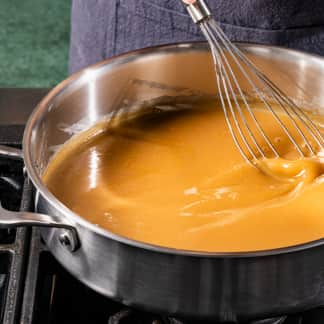The best fat separators drain from the bottom, which makes it possible to get every last drop of liquid while leaving the fat behind. They have large strainers and handles, so they’re especially easy to use. Our favorite is the OXO Good Grips Good Gravy Fat Separator–4 Cup. It does a stellar job of separating fat from liquid and is durable and a breeze to use. For a bit less, we also like the Trudeau 4 Cup Fat Separator. This pitcher-style fat separator is a little less efficient at separating fat from liquid, but it’s relatively easy to use and durable.

In the test kitchen, we often refrigerate stocks overnight so that we can skim off the hardened fat the next morning. But if you’re making gravy or soup on a shorter timetable, you can use a fat separator to defat stocks and pan juices almost immediately. To find a favorite, we tested a range of models, using them to strain aromatics and separate fat from both 2-quart and 1-cup volumes of stock.
There are two types of separators: pitchers and bottom-drainers. With both types, you pour your stock or sauce into the separator through a built-in strainer at the top and wait a few minutes for the fat to rise to the top of the liquid. If you’re using a pitcher, you then pour off the liquid from a spout set into the base. If you’re using a bottom-drainer, you pull a lever set in the handle to release a plug at the bottom of the separator, which allows the liquid to drain out. Either way, the fat is left behind in the separator.

What to Look For
- Bottom-Drainer Style Separators: In general, we preferred bottom-draining fat separators, as they proved to be more efficient than the pitchers at decanting both large and small volumes of liquid while keeping fat out. With the pitchers, some fat usually entered their pour spouts from the get-go, and as the liquid drained down to the last ¼ cup, it was harder to prevent fat from leaving too. Bottom-drainers didn’t have this problem; because the fat stayed on top of the liquid, all we had to do was to keep an eye on it and stop releasing the liquid when the fat got close to the bottom of the canister.
- A True 4-cup Capacity: A previous testing of fat separators showed us that a 4-cup capacity was the best size, giving users the flexibility to defat both large and small volumes of stock. Despite their manufacturers’ claims, however, several of the models we tested couldn’t actually hold 4 cups of liquid without overflowing. We preferred models that held the full 4 cups and then some.
- Strainers with Large Surface Areas and Tall Sides: Strainers with large surface areas provided us with bigger targets to hit when pouring stock and mirepoix from an unwieldy roasting pan. Strainers with sides taller than 1 inch acted as splash guards and helped keep solids in.
- Strainers with Lots of Little Holes: These allowed stock to drain quickly into the separators without letting through any small aromatics such as peppercorns or finely chopped onion.

- Large Handles: These were comfortable for testers of all hand sizes to grip.

- Clear, Accurate Measurement Lines: These made it easier to tell how much liquid we had.

- Durability: We preferred models that didn’t crack, warp, leak, or have their measurement lines fade after extended use and many washes.
What to Avoid
- Small Fat Separators: Fat separators with capacities under 4 cups require multiple batches to defat large batches of stock.
- Small Strainers with Low Sides: We had to be more careful and work more slowly when pouring into smaller strainers and those with low sides, as liquid could easily splash out.
- Inaccurate Measurements: Models with inaccurate measurements required us to dirty another measuring cup to get a precise sense of how much liquid we had.
The Tests:
- Separate 4 ounces of fat from 2 quarts of chicken stock poured in from a ladle
- Separate 1 ounce of fat from 1 cup of chicken stock poured in from a roasting pan
- Separate and strain 1 cup of stock enriched with chopped onion, bay leaves, thyme sprigs, and peppercorns and poured in from a medium saucepan
- Test with users of different hand sizes
- Wash once by hand
- Wash in dishwasher nine times
- Open and close bottom-drainers 150 times
How We Rated:
- Fat Separation: We gave more points to models that separated the greatest volume of liquid while minimizing the fat that dripped through.
- Ease of Use: We awarded more points to separators that were easy to fill, had legible measurement lines, did a good job of straining, and poured out stock neatly. We also gave more points to separators with big, comfortable handles.
- Cleanup and Durability: We preferred separators that were easy to clean by hand and that did not crack, warp, or fade in the dishwasher.
- Accuracy: We deducted points from separators that were smaller than their stated 4-cup capacity or that had inaccurate volume measurement lines.


















